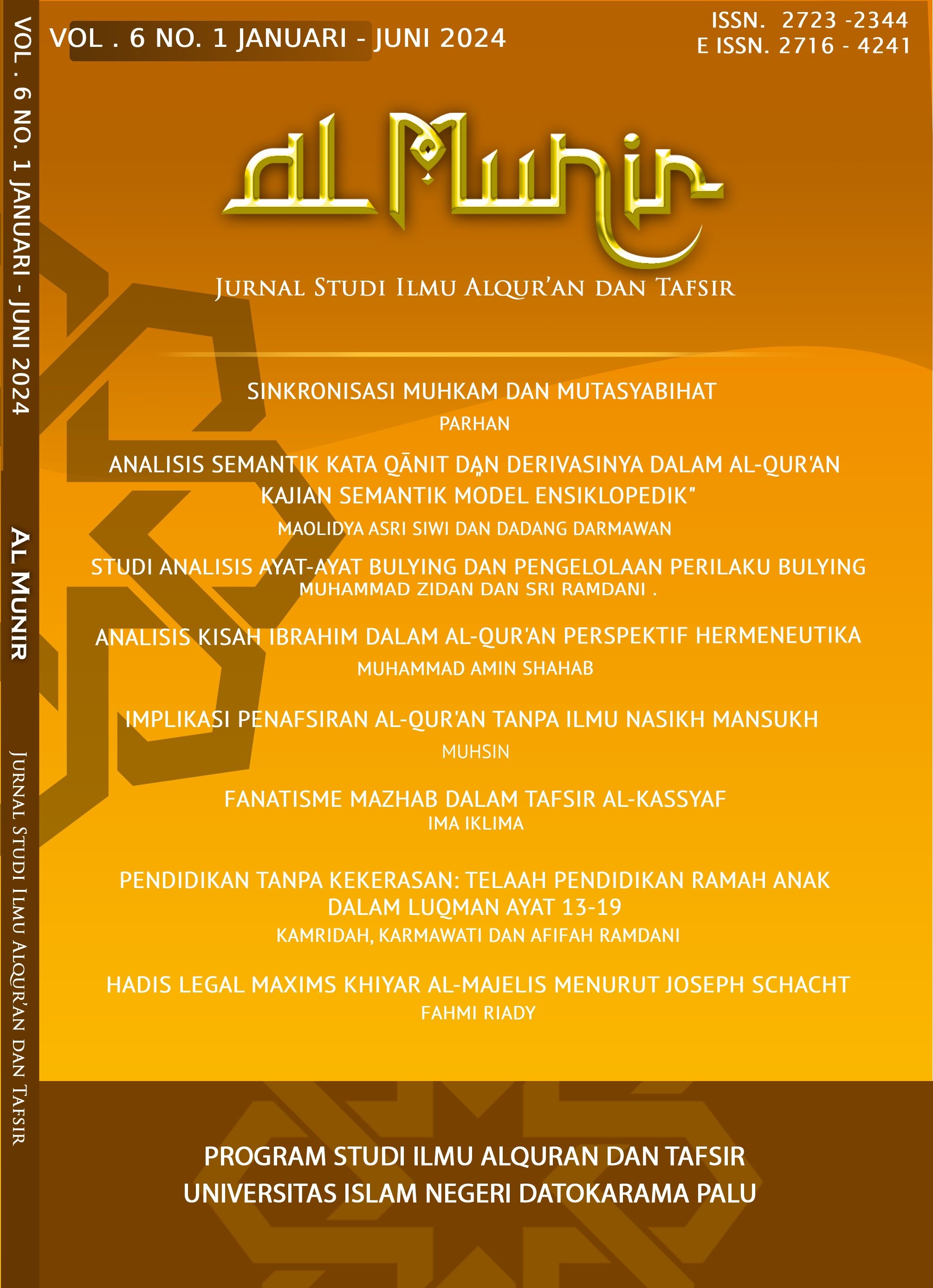ANALISIS SEMANTIK KATA QĀNIT DAN DERIVASINYA DALAM AL-QUR'AN "KAJIAN SEMANTIK MODEL ENSIKLOPEDIK"
Abstract
One of the important and interesting words to study in the Qur'an is qānit. At first glance, qānit means obedience. In addition, obedience in the Qur'an often uses the term tha'ah. So the word qānit becomes important to be studied in order to reveal what kind of obedience is meant in this word. The method used is qualitative with descriptive-analysis. While the approach used is the semantic ensiklopedik. There are previous studies that use the semantic ensiklopedik approach, but discuss the word maisir instead of qānit. Previous research also only discussed qānit in the aspect of fiqh. While this study will discuss qānit in the aspect of the Qur'an, namely looking for its meaning in order to improve the quality of worship. Qānit is repeated 13 times in 12 verses and 8 surahs. The basic meaning of qānit is obedience. While the meaning of qānit in the Pre-Qur'anic period is to follow something material, it is in contrast to the meaning of qānit in the Qur'an. Qānit in the Qur'an is in the context of worship, not material. So its meaning is to be consistent in obedience, both to Allah and to one's husband. There are 8 semantic fields, namely Allah, husband, spouse, Maryam bint Imran, Prophet Ibrahim, forgiveness, prayer and all of Allah's creations both in the heavens and on earth. The ways to be qānit for a wife include guarding her husband's property and maintaining her honor. For the general public, it is by keeping the five daily prayers, praying at night and asking for forgiveness. The reasons why one should be qānit include getting sustenance without calculation in this world and getting glorious sustenance in the hereafter in the form of heaven. This semantic ensiklopedik approach is proven to be able to cover the shortcomings that exist in Izutsu's semantics because the research becomes more focused, has benchmarks and is not wordy.
References
Adam, M. (2019). Tafsir Ayat-Ayat Qunut 2: Qunut Menurut Fukaha. Bandung: Marja.
Al-Asfahani, R. (t.t). Mu’jam Mufradat fi Gharib Al-Qur’an.
Al-Azdi, A. (t.t). Diwan Amr bin Malik Al-Azdi.
Az-Zuhaili, W. (2016). Tafsir Al-Munir: Aqidah, Syari’ah, Manhaj Jilid 2. Depok: Gema Insani.
Az-Zuhaili, W. (2016). Tafsir Al-Munir: Aqidah, Syari’ah, Manhaj Jilid 3. Depok: Gema Insani.
Az-Zuhaili, W. (2016). Tafsir Al-Munir: Aqidah, Syari’ah, Manhaj Jilid 7. Depok: Gema Insani.
Az-Zuhaili, W. (2016). Tafsir Al-Munir: Aqidah, Syari’ah, Manhaj Jilid 11. Depok: Gema Insani.
Az-Zuhaili, W. (2016). Tafsir Al-Munir: Aqidah, Syari’ah, Manhaj Jilid 12. Depok: Gema Insani.
Baqi’, M.F. (2020). Mu’jam Mufahras li Alfadz Al-Qur’an Al-Karim. Bandung: Diponegoro.
Darmawan, D, dkk. (2020). Desain Analisis Semantik Al-Qur’an Ensiklopedik: Kritik Atas Model Semantik Toshihiko Izutsu. Al-Quds: Jurnal Studi Al-Qur’an dan Hadis. Volume 4 Nomor 2.
Fangesty, MAS. (2022). Analisis Semantik Kata Hisab dan Derivasinya dalam Al-Qur’an. Skripsi. UIN Sunan Gunung Djati. Bandung.
Faris, A. (t.t). Mu’jam Maqayyis Al-Lughah Jilid 5. Dar Al-Fikr li At-Tiba’ati wa An-Nasyr wa At-Tauzi’.
Mandzur, I. (1990). Lisanul ‘Arab Jilid 1. Jakarta. Dar Al-Fikr.
Wahulwa, A. (2023). Analisis Semantik Makna Kata Maisir dan Derivasinya dalam Al-Qur’an: Studi Semantik Ensiklopedik. Skripsi. UIN Sunan Gunung Djati. Bandung.















